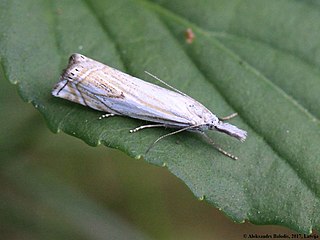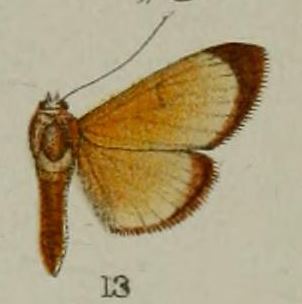
Crambus uliginosellus is a species of moth in the family Crambidae. It was first described by Zeller in 1850 and is currently found in most of Europe, except Portugal, Slovenia, Croatia and Ukraine.
Eoophyla nigerialis is a moth in the family Crambidae first described by George Hampson in 1906. It is found in Cameroon and Nigeria.
Eoophyla accra is a moth in the family Crambidae. It was described by Strand in 1913. It is found in Angola, Cameroon, the Republic of the Congo, the Democratic Republic of the Congo, Equatorial Guinea (Bioko), Ghana, Sierra Leone and Uganda.
Eoophyla ceratucha is a moth in the family Crambidae. It was described by Edward Meyrick in 1894. It is found on Borneo, Sumatra and Java.
Eoophyla tanzanica is a moth in the family Crambidae. It was described by David John Lawrence Agassiz in 2012. It is found in Tanzania.
Eoophyla mimicalis is a moth in the family Crambidae. It was described by George Hampson in 1917. It is found in Cameroon, the Republic of the Congo, the Democratic Republic of the Congo, Ghana, Kenya, Malawi, Nigeria, Sierra Leone, Tanzania and Uganda.
Nymphicula tariensis is a moth in the family Crambidae. It was described by David John Lawrence Agassiz in 2014. It is found in Papua New Guinea.
Parapoynx euryscia is a moth in the family Crambidae. It was described by Edward Meyrick in 1885. It is found in Australia, where it has been recorded from Tasmania and Victoria.
Eurhythma argyphea is a moth in the family Crambidae. It was described by Turner in 1913. It is found in Australia, in the Northern Territory.
Scoparia chiasta is a moth in the family Crambidae. It was described by Edward Meyrick in 1885. It is found in Australia, where it has been recorded from New South Wales.
Nacoleia alincia is a moth in the family Crambidae. It was described by Turner in 1908. It is found in Australia, where it has been recorded from Queensland.
Nacoleia glageropa is a moth in the family Crambidae. It was described by Turner in 1908. It is found in Australia, where it has been recorded from Queensland and New South Wales.
Nacoleia oncophragma is a moth in the family Crambidae. It was described by Turner in 1908. It is found in Australia, where it has been recorded from Queensland.
Pilocrocis fumidalis is a moth in the family Crambidae. It was described by George Hampson in 1912. It is found on Borneo.
Sedenia xeroscopa is a moth in the family Crambidae. It is found in Australia, where it has been recorded from New South Wales.
Samea antisema is a moth in the family Crambidae. It was described by Edward Meyrick in 1886. It is found on Vanuatu.

Syllepte solilucis is a moth in the family Crambidae. It was described by George Hampson in 1898. It is found in Western New Guinea, Indonesia.
Syllepte ageneta is a moth in the family Crambidae. It was described by Turner in 1908. It is found in Australia, where it has been recorded from Queensland.
Trigonobela nebridopepla is a moth in the family Crambidae. It was described by Turner in 1915. It is found in Australia, where it has been recorded from Queensland.
Ambia oligalis is a moth in the family Crambidae. It is found on the Louisiade Islands.
